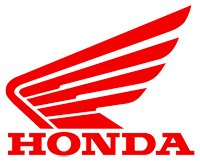
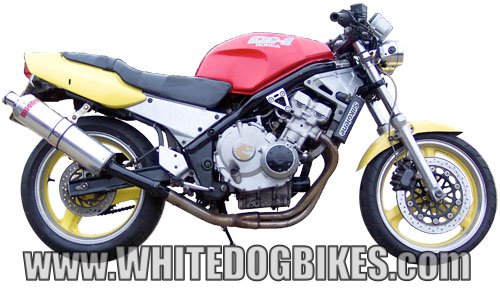
1990 Honda CB1 (NC27)
Honda CB-1 Specs…..
The Honda CB-1 was a short lived but surprisingly popular (in the UK) naked, 400cc bike that was released in Japan between 1989 and 1990.
The bike was also known by it’s official Honda model code (NC27) and as the CB400F in some countries it was marketed in.
The CB1 was originally released in Japan, but was later also released in the USA and Canada.
The CB1 was a fairly ‘sporty’ feeling bike, with a small and compact design and an engine based on the fully faired CBR400 NC23 (although the engine was de-tuned for the CB-1).
Need parts for your CB1? Honda CB-1 spares on Amazon…
A little bit about the Honda CB-1…..
Basic model info… |
|
|---|---|
| Manufacturer: | Honda |
| Model: | CB-1 |
| Honda model code: | NC27 |
| AKA (also known as): | CB1, CB400F |
| CC: | 399cc |
| Engine type: | Inline twin cylinder (4 stroke) |
| Countries officially released in: | Japan, United States and Canada (grey import in the UK) |
| Years in production: | 1989 to 1990 |
| Style of bike: | Naked bike |
| Insurance: | Group 8 (of 17) |
Models and years (in the UK) |
|
|---|---|
|
|
| CB-1 (1989 to 1990)….. | |
| Description: | Unfaired 399cc bike with 17 inch front and rear wheels, Showa 41mm front forks, single front disc brake and a engine based on a de-tuned NC23 engine. |
| Available colours: | Red, yellow and blue |
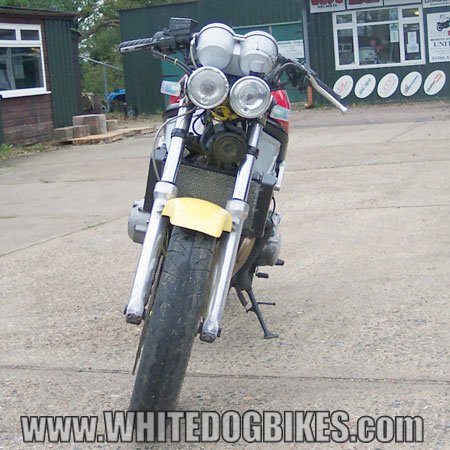
Honda CB1 front view. Fitted with aftermarket headlights.
Engine and gearbox specs….. |
|
|---|---|
| Displacement: | 399cc (24.3 cubic inches) |
| Engine type: | Inline 4 cylinder |
| Engine weight: | 57kg (126lbs) |
| Stroke: | 4 stroke |
| Bore×Stroke: | 55.0 x 42.0mm (2.17 x 1.65 inch) |
| No. of cylinders: | 4 (inline) |
| Firing order: | 1 – 2 – 4 – 3 |
| Cam shaft configuration: | DOHC (double overhead cam – gear driven) |
| Compression ratio: | 11.5:1 |
| Cylinder compression pressure: | 12.5 to 13 bar (182 to 188 psi) |
| Valves: | 16 valve (4 per cylinder) |
| Spark plug: | NGK CR8EH-9 (x4) |
|
|
| Spark plug gap: | 0.8 to 0.9mm |
| Engine oil system: | Forced pressure from a wet sump in bottom of the engine |
| Oil pump: | Trochoid type oil pump |
|
|
| Engine oil: | 10w40 API SG or higher
|
| Engine oil capacity (with filter change): | 3.1 litres |
| Engine oil capacity (without filter change): | 2.9 litres |
| After engine rebuild/disassembly: | 3.5 litres |
| Engine oil drain bolt location: | Bottom/right of the engine oil sump (right as your sitting on the bike) |
| Oil filter type: | Canister type |
| Oil filter: | Hiflo HF303 / Filtrex OIF006 |
| Oil filter torque: | 10nm |
| Oil pressure: | 4.9 bar / 71psi (at oil pressure switch) |
| Clutch: | Wet (oil immersed) multiplate clutch |
| Clutch operation: | Mechanical / cable |
| Clutch lever free play: | 10 to 20mm |
| Gearbox: | 6 Speed manual |
| Gearbox configuration: | 1st Gear down, 2nd to 6th gears up, neutral between 1st and 2nd gears (1 – N – 2 – 3 – 4 – 5 – 6) |
| Gear change operation: | Pedal operated by left foot |
| BHP (claimed!): | 55 bhp (@ 10,000 rpm) |
| Torque (claimed!): | 29 ft/lb (@ 9,500 rpm) |
| Top speed (claimed): | 118mph |
|
|
| Piston ring to cylinder bore clearance: | 0.10mm (max service limit) |
| Valve clearance (inlet): | 0.12 – 0.18mm (when cold) |
| Valve clearance (exhaust): | 0.17 – 0.23mm (when cold) |
| Idle speed: | 1,300rpm (1,400rpm for California models – +/- 100) |
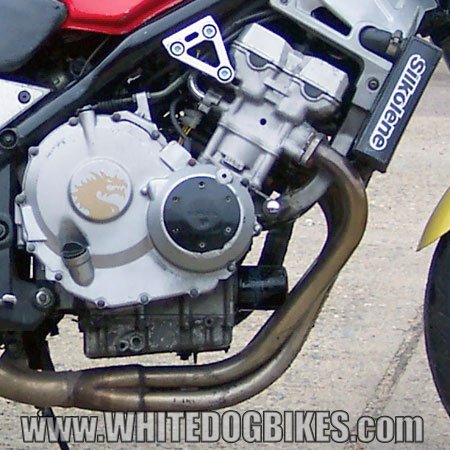
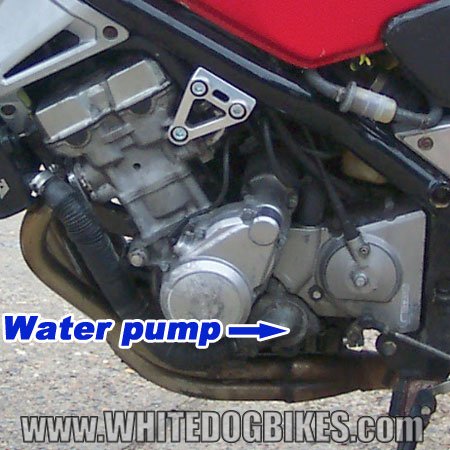
Honda CB1 399cc, inline 4 cylinder engine
Cooling system stuff….. |
|
|---|---|
| Cooling system: | Liquid cooled |
| Cooling system capacity (complete system – radiator, engine and reservoir): | 1.8 litres |
| Cooling system capacity (engine and radiator): | 1.5 litres |
| Cooling system capacity (reservoir only): | 300ml |
| Water pump location: | Bottom/left of engine (just infront of the front sprocket cover) |
| Coolant reservoir location: | Front/right, underneath the seat (between the back of the tank and the battery) |
| Water pump drain bolt location: | Bottom of the water pump (lowest short bolt on the pump) |
| Thermostat begins to open at: | 80 to 84 degrees C |
| Thermostat fully open at: | 95 degrees C |
| Fan motor switch turns on at: | 98 to 102 degrees C |
| Fan motor switch turns off at: | 93 to 97 degrees C |
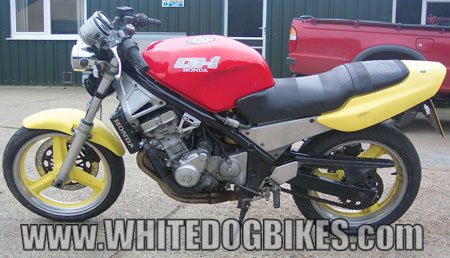
Left side view of a 1990 Honda CB1
Final drive stuff….. |
|
|---|---|
| Final drive: | Chain |
| Front sprocket: | 15 teeth |
| Front sprocket nut tightening torque: | 55mm |
| Rear sprocket: | 37 teeth |
| Rear sprocket nut tightening torque: | 65mm |
| Chain pitch/length: | 525 pitch / 104 links |
| Chain free play: | 15 to 25mm |
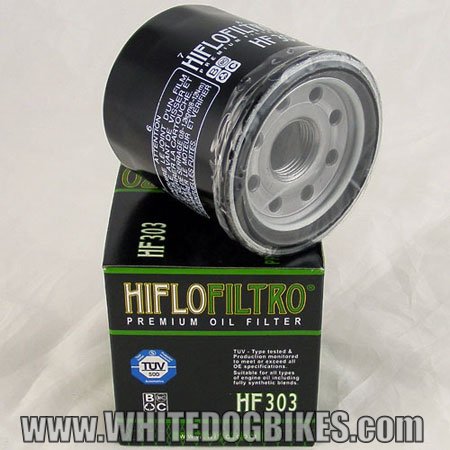
Honda CB1 (NC27) canister type oil filter (Hiflo HF303)
Carb, fuel and oil stuff….. |
|
|---|---|
| Fuel system: | Carburetor |
| MPG (average): | 44 miles per gallon (very approx)
|
| Fuel tank capacity: | 11.5 litres |
| Fuel tank reserve capacity: | 3.5 litres |
| Fuel type: | Unleaded petrol (91 octane grade – aka standard petrol from your local garage) |
| Carb make: | Keihin CV32 (4x) |
| Carb type: | VG06B (VG06C in California) |
| Pilot screw opening: | 1 turn |
| Throttle grip free play: | 2 to 6mm |
| Engine oil: | 10w40 API SG or higher
|
| Engine oil capacity (with filter change): | 3.1 litres |
| Engine oil capacity (without filter change): | 2.9 litres |
| After engine rebuild/disassembly: | 3.5 litres |
| Engine oil drain bolt location: | Bottom/right of the engine oil sump (right as your sitting on the bike) |
| Engine oil drain bolt tightening torque: | 35nm |
| Oil filter type: | Canister type |
| Oil filter: | Hiflo HF303 / Filtrex OIF006 |
| Oil filter torque: | 10nm |
| Oil pressure: | 4.9 bar / 71psi (at oil pressure switch) |
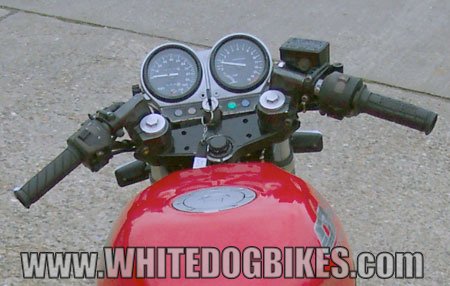
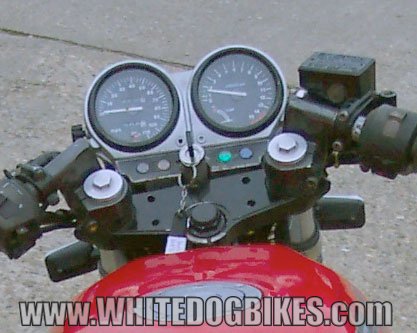
Layout of the clocks and handlebars on a CB-1 (NC27)
Electric stuff….. |
|
|---|---|
| Ignition type: | Electronic CDI |
| Starter: | Electric start |
| Electrical system voltage: | 12 volts |
| Battery voltage (fully charged): | 12.8 volts |
| Battery amps per hour: | 8 a/h |
| Battery will need charging if below: | 12.5 volts |
| Battery charging current (normal): | 0.9 amps on a 5 to 10 hour charge |
| Regulated voltage: | 14 to 16 volts (@ 5000 rpm) |
| Spark plug: | NGK CR8EH-9 (x4) |
|
|
| Spark plug gap: | 0.8 to 0.9mm |
| Spark plug tightening torque: | 11nm |
| Spark plug ignition: | 2 x coil |
| Battery: | CTX9-BS / YTX9-BS / CBTX9-BS
|
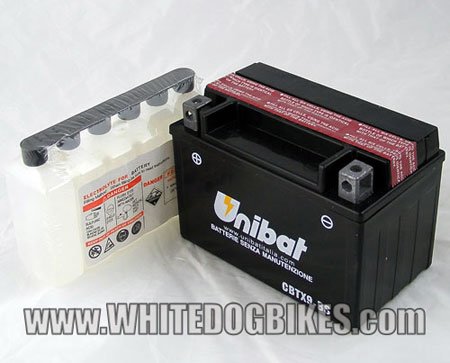
Honda CB-1 battery (YTX9-BS)
Shocks, brakes and wheel specs….. |
|
|---|---|
| Front wheel type: | 3 spoke cast wheel |
| Front tyre size: | 110/70-17 |
| Front tyre pressure: | 33psi (2.3 bar) |
| Front wheel spindle torque: | 60nm |
| Front wheel spindle clamp bolt torque: | 22nm |
| Rear wheel type: | 3 spoke cast wheel |
| Rear tyre size: | 140/70-17 |
| Rear tyre pressure: | 36psi (2.5 bar) |
| Rear wheel spindle torque: | 90nm |
| Front brake: | Single hydraulic disc brake with 2 piston caliper |
| Front brake disc: | 310mm single disc. Part no: EBC MD1038RS (1x) |
| Front brake pad: | EBC FA142 (1x) |
| Rear brake: | Single hydraulic disc brake with 1 piston caliper |
| Rear brake pad: | EBC FA140 (1x) |
| Rear brake disc: | Single 240mm disc. Part no: EBC MD1020 (1x) |
| Brake fluid (front and rear): | DOT 4 brake fluid |
| Front suspension: | Telescopic forks (Showa) |
| Front fork stanchion diameter: | 41mm |
| Recommended fork oil: | 10w (medium weight) fork oil |
| Fork oil volume: | 510 ml (per fork) |
| Front wheel travel (up/down): | |
| Rear suspension: | Single rear monoshock |
| Rear shock type: | Gas filled (nitrogen) with preload adjustment |
| Rear shock top mounting bolt torque: | 45nm |
| Rear shock bottom mounting bolt torque: | 45nm |
| Rear shock lower joint bolt torque: | 68nm |
| Rear wheel travel (up/down): | 110mm |
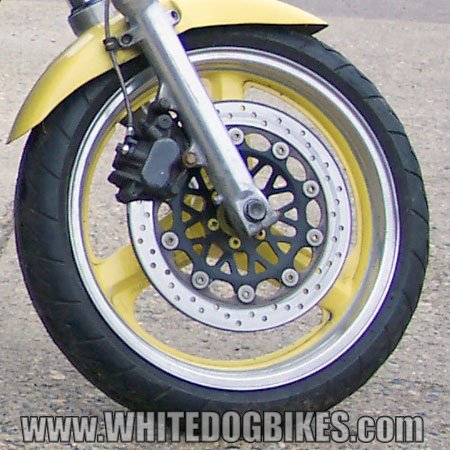
110/70-17 Front wheel with single front disc on a Honda CB-1
Weights, measures ‘n stuff….. |
|
|---|---|
| Overall length: | 2,035mm |
| Overall width: | 705mm |
| Overall height: | 1,025mm |
| Wheelbase: | 1,370mm |
| Seat height: | 775mm |
| Footpeg height: | 335mm |
| Ground clearance: | 130mm |
| Dry weight (no oils, fluids etc): | 170kg |
| Kerb weight (with oil, coolant etc – approx): | 183kg |
| Max weight capacity: | 157kg |
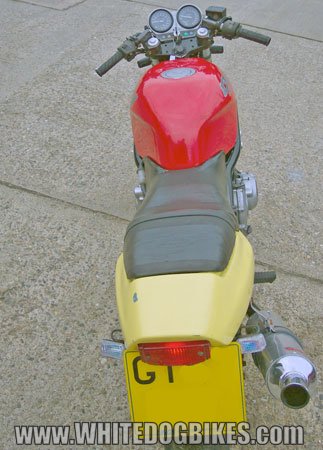
Top view of a 1990 Honda CB400F NC27
Useful torque settings….. |
|
|---|---|
| General nuts, bolts, screws and fastners… | |
| 5mm bolt and nut: | 5nm |
| 6mm bolt and nut: | 10nm |
| 8mm bolt and nut: | 22nm |
| 10mm bolt and nut: | 35nm |
| 12mm bolt and nut: | 55nm |
| 5mm screw: | 4nm |
| 6mm screw: | 9nm |
| 6mm flange bolt (with 8mm head): | 9nm |
| 6mm flange bolt (with 8mm head): | 12nm |
| 8mm flange bolt and nut: | 27nm |
| 10 mm flange bolt and nut: | 40nm |
| Specific/important nuts, bolts and fastners… | |
| Oil pressure switch: | 12nm |
| Oil drain bolt: | 35nm |
| Oil filter: | 10nm |
| Spark plugs: | 11nm |
| Front sprocket nut: | 55mm |
| Rear sprocket nuts: | 65mm |
| Front wheel spindle torque: | 60nm |
| Front wheel spindle clamp bolt torque: | 22nm |
| Rear wheel spindle torque: | 90nm |
| Front brake caliper bolt: | 30nm |
| Rear brake caliper bolt: | 30nm |
| Cylinder head cover bolt: | 10nm |
| Camshaft holder bolt: | 12nm |
| Alternator flywheel bolt: | 85nm |
| Engine mount nut (front): | 40nm |
| Engine mount nut (rear/upper): | 50nm |
| Engine mount nut (rear/lower): | 50nm |
| Front brake disc bolt: | 30nm |
| Front caliper bracket bolt: | 27nm |
| Front caliper bolt: | 23nm |
| Rear brake disc bolt: | 40nm |
| Rear caliper bolt: | 23nm |
| Rear shock top mounting bolt: | 45nm |
| Rear shock bottom mounting bolt: | 45nm |
| Rear shock lower joint bolt: | 68nm |
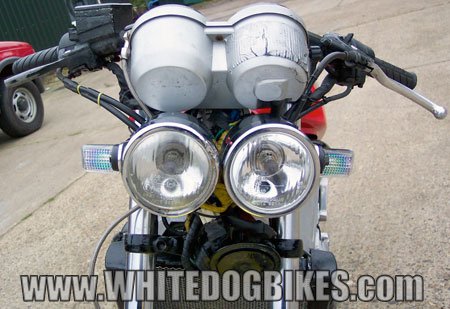
Front view of a Honda CB1 (NC27) with aftermarket ‘streetfighter’ headlights
Service stuff….. |
|
|---|---|
| Servicing your bike? You’ll need tools and CB-1 parts… | |
| Engine oil | |
| Engine oil change frequency: | Every 12,800km (approx 7,900 miles) or 12 months |
| Engine oil: | 10w40 API SG or higher
|
| Engine oil capacity: | 3.1 litres |
| Engine oil drain bolt location: | Bottom/underneath of the engine |
| Oil filter: | Hiflo HF303 / Filtrex OIF006 |
| Oil filter torque: | 10nm |
| Chain drive | |
| Final drive chain check frequency: | Now repeat after me… ‘I MUST LUBE MY CHAIN LITTLE AND OFTEN!!’ At least once a week… |
| Chain and sprocket size: | 104 link / 525 pitch Chain, 15 tooth front and 37 tooth rear sprocket |
| Hydraulic brake system (front and rear) | |
| Brake fluid check frequency: | Check every 12 months or 6,400km (approx 3,900 miles) |
| Brake fluid change frequency: | Change every 24 months or 19,200km (approx 11,900 miles) |
| Brake fluid: | DOT 4 brake fluid |
| Fork oil | |
| Front fork oil check frequency: | Check every 12,000km (approx 7,456 miles) or 12 months |
| Recommended fork oil: | 10w (medium weight) fork oil |
| Fork oil volume: | 510ml (per fork) |
| Cooling system | |
| Coolant check frequency: | Check every 12,800km (approx 7,900 miles) or 12 months |
| Change every: | 38,400 km (approx 23900 miles) or 24 months |
| Cooling system: | Liquid cooled |
| Cooling system capacity: | 1.8 litres |
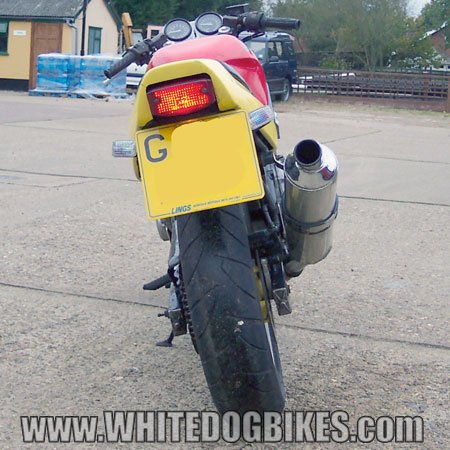
Back view of a 1990 CB-1 NC27
Frame number location…..
The frame number is stamped onto the right side of the headstock (the front part of the frame just below the handle bars).
There is also a information plate on the right of the bike, on the frame just behind the headstock and just below the tank.
Engine number location…..
On the right side of the engine crankcase, just behind where the clutch cable joins the clutch arm (the engine number usually starts ‘NC23….’.
Useless stuff…..
Although the CB-1 wasn’t a popular bike for Honda, it has proved popular in other countries where it was officially released and in countries, like the UK, where it was imported as a ‘grey import’.
The CB1 was released at a time when the market was changing and people weren’t looking for sporty. unfaired bikes and were looking for sportier, fully faired bikes (e.g. CBR400, CBR600 etc). This meant the CB1 was a hard sell for Honda. Officially, the bike was sold between 1989 and 1990, but it was available new up until 1992 in some countries at a discounted price to clear stock (the bike was known as the CB400F in the US).
The CB1 has proved popular with newer, 1st ‘big bike’ riders, couriers and, due to it’s smallish size and low seat height, shorter riders.
The sporty ride of the bike is achieved, it part, by the frame design and clip on handle bars (as opposed to more traditional handle bars used on many ‘naked’ bikes) and the use of an engine based on the CBR400RR NC23 engine. The CBR400 engine was de-tuned for the CB-1, with changes to the port lengths as well as smaller valves and lower compression ratio. Other changes were in the primary and secondary gear ratios which meant the 1st gear speed was reduced from 60 mph (in the CBR400) down to around 30 mph (although this meant the CB1 was quicker off the mark then the CBR400!).
Although never official in the UK, there have been many CB1’s with upgrades and extras over the years. Many have been modified with a CBR400 forks and front brake system, which converts the single front disc brake to a twin front disc brake, as well as braided brake hoses, performance and home made exhaust systems and other parts.
Buying advice…..
Firstly, if your thinking of buying one always HPI check it (there’s still loads about so no point risking getting stuck with a lemon!).
These are good, solid bikes and are ideal for 1st time ‘big bike’ riders as well as shorter (lady) riders. Mileage isn’t really anything to worry about (within reason!), but obviously a bike that’s had frequent oil changes is likely to be better.
As the bike was a naked/unfaired bike there’s wasn’t alot of fairing to damage and indicators, headlights etc could be easily replaced, if damaged, with aftermarket parts.
Obviously, the youngest of these bikes will be 27 years old now so if your buying you’ll need to check any metal parts, especially exhausts, forks and similar (also check the availability of parts as grey import bike aren’t always the easiest to get parts for!).
Although the CB-1 is fairly reliable (gear driven cams etc), there are a fair few ex courier and winter bike hacks around, which aren’t always a bad buy, but will invariably always need something doing to them.
Common part’s like reg/recs, brake pads, clutches, chain and sprocket kits, caliper pistons where shared between a few Honda models to these parts aren’t difficult or expensive to source.
Happy biking 🙂
Sources / Thanks to / Useful CB1 sites:
CB-1 article on Wikipedia
Honda CB1 service manual (pdf)
If you’ve got any questions, comments or suggestions please feel free to leave them below 🙂
Disclaimer: The information on this page is correct to the best of our knowledge. But the info should NOT be taken as 100% accurate as we can, occasionally make mistakes!

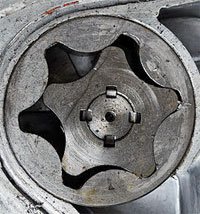
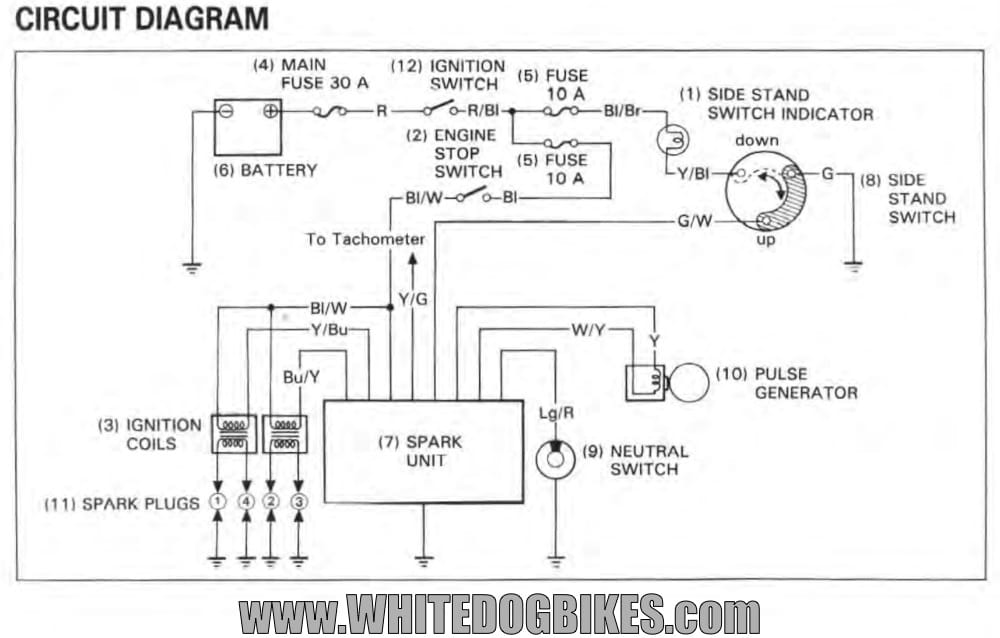

Leave a Reply